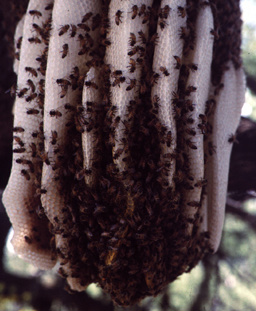
Honey bees live in large family groups called colonies. A full-sized colony at the height of the growing season contains an average of 60,000 individual bees. Honey bees tended by beekeepers live in wood boxes called hives (See Activity Sheet 5). Some well-managed hives in bee yards contain up to 80,000 individual bees.

The central structure of the colony is the wax comb. It is made up of six-sided, white wax chambers or cells. The cells vary in size according to the purpose. Smaller chambers are for raising female worker bees, larger ones are for raising male drones. Queen chambers are the largest. The comb is made of beeswax, a substance secreted from worker bee abdominal glands. The wax is secreted as tiny flakes, which are then chewed and molded into cells. Other construction in and around the hive is done with propolis, a sticky substance bees manufacture from tree and plant resin. The comb contains the stored honey and is home for the immature bees.
Honey bees usually build their comb in a protected area or cavity with an access hole the size of a pencil eraser or larger. Wild (feral) honey bees nest in enclosed areas such as a hole in a tree if possible, but sometimes they will construct comb out in the open on a thick branch of a tree or under rock outcroppings. The elaborate exposed combs full of amber-colored honey they construct can be very beautiful.
Africanized honey bees are far less selective than European honey bees about where they will set up a colony. They will occupy a much smaller space than the European honey bee. They also seem to prefer to nest closer to the ground. Water meter boxes, mail boxes, animal burrows, trash, debris, even an empty soda pop can could be viewed as "home" to Africanized honey bees.
Honey bees move from site to site by swarming . A portion of the bees leave the colony with the old queen and take up residence in a new location. Africanized honey bees tend to swarm more often than European honey bees, and are also more likely to abscond. When bees " abscond" they all take off to find a new nest, rather than just a portion of the workers leaving. Bees typically abscond when they sense a threat to their colony or when foraging opportunities have almost been exhausted in the present location. Africanized honey bees have been selected over centuries to survive in areas where scarcity of resources is common and absconding is the only alternative if the colony is to survive.